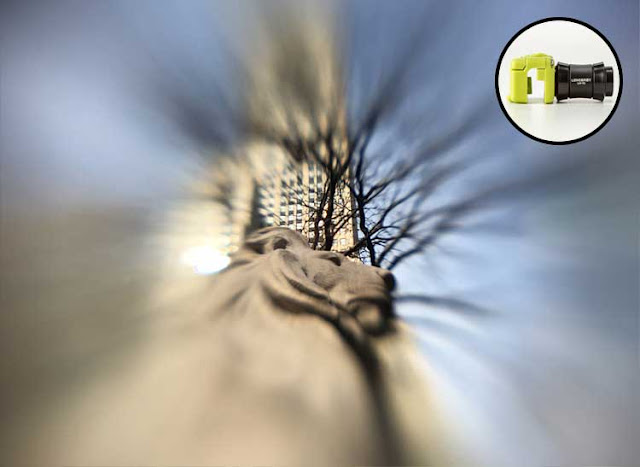Summer means celebrations—weddings,
graduations, pool parties—so you’ll soon be calling up your smartphone’s
camera quite a bit, especially if you’re active on social media. And,
let’s be honest, that’s practically a competitive sport these days.
(What good is a picture if no one sees it, right?)
If you’re ready to raise your game, perhaps you should think about
adding a mobile camera lens to your arsenal—the kind that attaches to a
phone with a clip or magnet.
These lenses are inexpensive, easy to use, and fit in the palm of
your hand, granting you a kaleidoscope of options previously reserved
for people who own pricey cameras and a bagful of lenses the size of
your forearm. Think wide-angle, fish-eye, telephoto, and macro lenses,
but also specialty models, like a soft-focus option. Most can be
purchased individually or in kits that let you experiment with multiple
lenses, depending on what the moment calls for.
From left: Mobi-Lens Wide, Photojojo Super Fisheye, Olloclip Macro Kit, Lensbaby LM10, and Olloclip Active Kit
Photo: Terry Sullivan
I ordered several mobile camera lenses—they are sold individually and in kits—and then experimented with the five shown above, using an iPhone 6s and an LG V10 to take photos at the New York Public Library. The lenses were as simple to operate as I expected, and I'll provide details on how to use each lens below.
But first, here are a few things to know before you give any of these products a try:
- Most cover up the phone’s flash, so you can’t really use them in poorly lit places.
- Most require you to remove the phone’s case before attaching the lens to the phone.
- They're not compatible with every phone. In general, you’ll find more lenses made for iPhones than for Android phones. So before you buy a mobile camera lens, check the manufacturer’s website to confirm its compatibility with your phone. For a good, versatile choice, take a look at Photojojo’s lenses, which attach magnetically to the front of any mobile device.
- And it’s wise to try before you buy, if possible, to make sure you’re happy with the way a lens operates. At the very least, make sure you can return the item if you’re not satisfied.
Wide Lens, $30 (Mobi-Lens’s Wide-Angle Lens)
What It Does: Expands the field of view so you can capture the sweep of a dramatic landscape or fit more people into a group photo.
Novice photographers often overlook those benefits, but the truth is a
wide-angle lens can be just as useful as the more popular telephoto.
This Mobi-Lens model sells for $30. You can also opt to buy it in a
package with a fish-eye lens for $50.
According to Mobi-Lens, its mobile camera lenses are designed to fit
any phone. This option is easy to attach but also pretty easy to knock
askew. One of its biggest selling points: You don’t have to remove the
phone’s case to use the lens like you do with many other models.
Photojojo Super Fisheye Lens, $20
What It Does: Creates an extremely wide-angle image with noticeable distortion at the edges of the frame.
Not everyone wants their family portraits to look like the cover of Jimi Hendrix’s “Are You Experienced?” vinyl album. But some people love the surreal look that a fish-eye lens brings to architecture and landscapes. The closer you are to the subject, the more warped the resulting photo will turn out.
For a traditional camera, a fish-eye lens can be cost-prohibitive,
but this $20 mobile camera lens lets you indulge your inner Salvador
Dalí without having to become a starving artist in the process. So fire
away!
Olloclip Active Lens Kit, $100
What It Does: Magnifies the subject without lowering the image
quality. This is different from the zoom function on most smartphones,
which uses digital tricks to zero in on a subject, often producing a
grainy effect.
With a telephoto lens, you can’t zoom in or out. Instead you choose a
lens that enlarges the subject by a specific amount. For example, a 2x
telephoto lens (like the one used here) draws you twice as close to the
action.
For portraits or candids, that’s often all you need. And the close-up
images are clear and crisp, thanks to what’s called optical zoom. This
telephoto lens from Olloclip is sold in several kits; the option we
chose also includes a wide-angle lens.
What It Does: Allows you to capture small details at ultra-close range.
The lens on your phone can’t focus on anything nearer than, say, 10
inches away. So when you see a dramatic, frame-filling close-up, it has
been shot with a macro lens. The blurred background serves to highlight
the detail you focused on.
Just take care as you compose the shot. If you’re photographing
someone’s face, for example, you’ll have to choose a feature such as the
eyes to be the center of attention.
In this instance, the image was magnified 21 times; Olloclip’s Macro Lens kit also includes 7x and 14x macro lenses.
Lensbaby Deluxe Creative Mobile Lens Kit, $120
What It Does: Produces a blurred effect that creates dramatic distortions, particularly in brightly lit or shadowy areas.
Though most lens manufacturers try to create the sharpest images possible, Lensbaby seems to love distorting them. Its Deluxe Creative Mobile Lens kit comes with two soft-focus lenses and a reflecting lens that creates a kaleidoscope effect. The LM10 soft-focus lens produces a larger halo of blur than the LM20.
All three lenses easily attach to your phone with a magnetized
bracket. Before you start snapping shots, you’ll want to download the
Lensbaby Mobile app (free for Android and Apple devices), which lets you
switch between still and video modes and also gives you access to more
features, such as switching the focal point from image to image.
source
source






